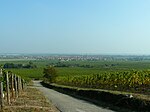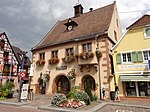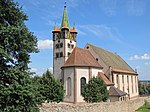Sélestat station
Grand Est railway station stubsRailway stations in Bas-RhinRailway stations in France opened in 1840

Sélestat station (French: Gare de Sélestat) is a railway station serving the commune of Sélestat, Bas-Rhin department, France. It is located at the junction of the Strasbourg–Basel railway with the branch lines towards Molsheim and Lièpvre. The station is owned and operated by SNCF, in the TER Grand Est regional rail network and is served by TER trains.
Excerpt from the Wikipedia article Sélestat station (License: CC BY-SA 3.0, Authors, Images).Sélestat station
Rue de la Gare, Sélestat-Erstein
Geographical coordinates (GPS) Address External links Nearby Places Show on map
Geographical coordinates (GPS)
| Latitude | Longitude |
|---|---|
| N 48.26011 ° | E 7.44316 ° |
Address
Sélestat
Rue de la Gare
67600 Sélestat-Erstein
Grand Est, France
Open on Google Maps









